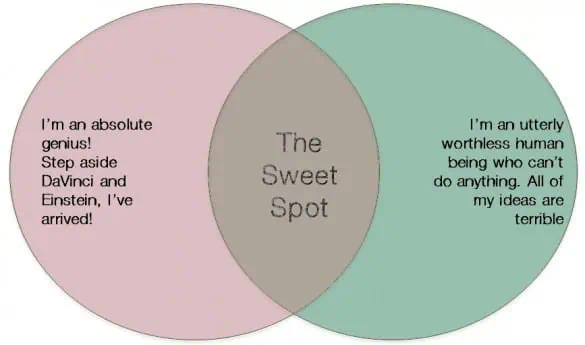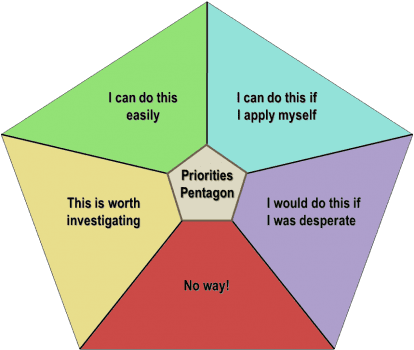Like many creatives and entrepreneurs, I suffer from an affliction – it’s called ‘Having-Too-Many-Ideas’, also known as ‘Idea-ism’.
Symptoms of Too Many Ideas Syndrome include Crippling indecision. Procrastination. Frequent bouts of self-doubt punctuated with delusions of grandeur. Notebooks full of scribbles. A camera full of pictures. A ridiculous number of Pinterest boards. Thousands of half-finished projects. No breathing space in your day. A brain full of ideas trying to get out at the most inconvenient times and frequent daydreaming.
But too many ideas syndrome is still a lot better than having no ideas. Life is full of possibilities. The trick is to know when and how to apply some rational thinking. This article shows you how.
Too Many Ideas Sweet Spot
One of the bitterest aspects of this disorder is that we need those moments of hyper-confidence and extreme insecurity to enable us find an acceptable level of comfort in order to live with this condition. This is ‘the Sweet Spot’, the moment where our ideas become practical actions.
Remedies for Too Many Ideas
There is no cure for a creative and inquiring mind, but there are many simple remedies to alleviate some of the symptoms and help you to find the Sweet Spot.
The first step is to accept that you have Too Many Ideas Syndrome and that you need to do something about it. Start by researching and experimenting with some of the remedies from this list.
Write it down
Writing it down helps get it out of your head, making space for other priorities. Ideas marinate much better on a page than in your brain.
Start a blog
A blog is a great way to share your thoughts, ideas and inspirations openly and invite feedback.
Improve your time management
Learn some time management techniques and experiment with different tools. Prioritise and accept that you can’t do everything all at once, so be sensible about what you can and can’t do and by when.
Read: books, blogs, magazines and content, etc.
There is a wealth of information out there. I recommend Pinterest as a simple way to collate links to websites, content and blogs. But don’t just collect it, go through it and plan the resulting actions into your day.
Find a mentor
Either a formal or informal mentoring relationship where you can bounce ideas around, get encouragement, take practical action or just get a kick up the backside.
Do a skills course or workshop
Often we’ll have an idea but are unsure how to implement it. Perhaps your IT skills need updating or you’d like to find a simpler or more professional way to do something.
Go on a Business Course
Learn to be more businesslike in your approach and get some focus and clarity before taking your next steps. A practical business course will give you project management tools, space to discuss ideas with like-minded people, structure, and new contacts.
Get feedback
Join critique groups, clubs, host a focus group, join a forum, etc. Don’t be afraid to ask people what they think or to seek advice. Most people are happy to help (as long as you ask nicely).
Assess Your Ideas
If you would prefer to self-medicate, here’s a tool to help you to decide, realistically, what you can and can’t do and what you are willing or unwilling to do.
- Start by mind-mapping your ideas, either on your own or with someone else
- Write down everything that you think of or that is suggested to you – initially, treat it as an info. dump. Don’t edit, let the ideas flow
- Next, go through your list and allocate each idea or task to the appropriate category:
1. I can do this easily
In this category, place the things you are both willing and able to do and need minimal support to achieve. These are the things you know inside out and back to front, the things you do on autopilot. It’s important to include here the things that you enjoy.
2. I can do this if I apply myself
These are things you have some knowledge or experience of and are willing to do. You may need to get help with them, seek advice or learn some new skills, but the reward would justify the effort.
3. Worth investigating
These are things you are interested in but may have little experience of. They may involve more comprehensive research and as a result are likely to take more time to get established.
4. Would do if desperate
These are the things you are capable of doing and could probably make some quick money with but you may not enjoy them. These could be your contingency plans.
5. No way
This is the stuff you won’t do. Stuff that maybe you can’t do or are unwilling to consider at this point.
Tips:
- Draw a pentagon on a big piece of paper. Write the tasks/ideas on individual sticky notes, shift them around and play with where they belong.
- Don’t be afraid to be ruthless when deciding on categories.
Wrap Up – Living with Too Many Ideas
Having Too Many Ideas Syndrome is a lot better than having zero ideas. Sure your head will be buzzing all the time but your life is colourful and full of potential and opportunity. Just make sure that you use our tips to capture the ideas when they are at their most potent, and then assess them.
If the idea is realistic and viable, then the next step is to act and make it happen. Don’t leave those brilliant ideas in your notebook!



